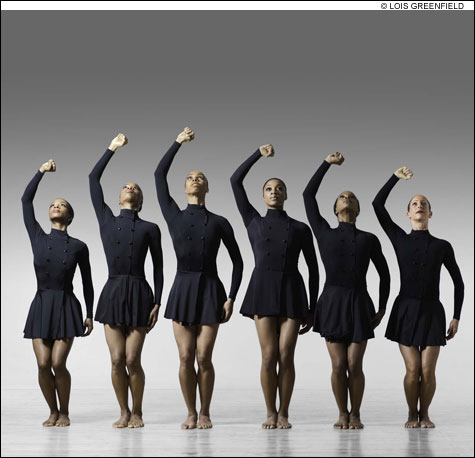
ENEMY BEHIND THE GATES: Bad timing? |
The four pieces on the program that Philadanco brought for its Boston debut last weekend at the Institute for Contemporary Art were all-dance numbers showcasing a troupe of highly polished, supercharged dancers. Except for one sextet of women, each work marshaled 10 or more members of the company's 16-person roster. Despite the jam-packed choreography and the unremittingly high-performance intensities, by the end of the evening they looked even more revved up than they'd been at the start.Founded in 1970, Philadanco is Philadelphia's answer to Alvin Ailey, a company of mostly African-American dancers who've mastered the gamut of contemporary styles. Their choreography comes with messages of uplift and reflection, but the dances themselves — at least the ones we saw here — don't detour us away from the pure pleasures of physicality. They differed in big issues of style and mood, but all the choreographers were working with small chunks of group arrangements, people streaming in and out with little to distinguish them from their companions.
The program started with a revival of the late Gene Hill Sagan's 1983 Ritornello, which is choreographed to a familiar score with a daunting predecessor. Bach's Double Violin Concerto is also the music for George Balanchine's Concerto Barocco, a classic in the ballet repertory. Sagan's alternative was enjoyable if not profound.
Four men and six women used a hybrid vocabulary of ballet and modern-dance steps — fast chaînû turns, running, skipping, stag jumps borrowed from Martha Graham. The arms were always in motion, curling and spreading in an effect that modern dancers like Paul Taylor have used to extend and glamorize the non-balletic body. To the slow second movement, two couples danced almost entirely in tandem. When the men weren't tipping the women up in odd, angular lifts, they made pliant plastique shapes to set off the women's pointe-free bourrûes, arabesques, and developpûs.
Rennie Harris proposed a social history in Philadelphia Experiment, but the theme of slavery and its legacy of urban despair was assigned to photographs projected on the backdrop and a singer insistently exhorting us to remember past abuses. The dance itself was a fast, punchy montage of hip-hop, boogie, and sassy street attitude. It looked like a chorus for a music video or a rap show to me.
At the end, as the audience screamed its head off, the stage lights came on again. A leader (unidentified as such in the program notes), who'd strutted around and solo'd during the piece, pumped up the audience even more as the cast returned for a long, choreographed encore with more boogieing and little specialty bits.
Christopher L. Huggins contributed two pieces. From Dawn 'til Dusk was a small ensemble for women set to Bobby McFerrin riffing on spiritual tunes. The sextet began with promising goofiness, all lying in a row with their heads toward the audience and gesturing with hands, feet, and heads in time to McFerrin's music. But then they reverted to stereotyped portraits of femininity, running in and out like innocent young girls. Then they sped through a desperate but still pretty lament. They reminded me of the lost souls in Alvin Ailey's House of the Rising Sun.